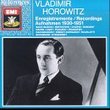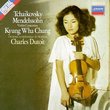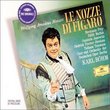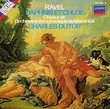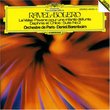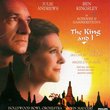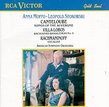| All Artists: Luigi Cherubini, Riccardo Muti, Marianna Pizzolato, Bavarian Radio Symphony Orchestra, Harald Feller, Max Hanft, Ruth Ziesak, Barbara Fleckenstein, Herbert Lippert, Bernhard Schneider, Andreas Meyer Title: Cherubini: Missa solemnis in E Members Wishing: 0 Total Copies: 0 Label: EMI Classics Original Release Date: 1/1/2007 Re-Release Date: 8/14/2007 Genre: Classical Styles: Opera & Classical Vocal, Historical Periods, Classical (c.1770-1830), Symphonies Number of Discs: 1 SwapaCD Credits: 1 UPC: 094639431625 |
Search - Luigi Cherubini, Riccardo Muti, Marianna Pizzolato :: Cherubini: Missa solemnis in E
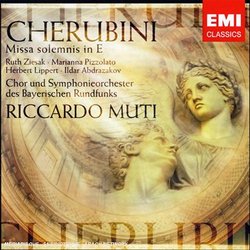 | Luigi Cherubini, Riccardo Muti, Marianna Pizzolato Cherubini: Missa solemnis in E Genre: Classical
|
Larger Image |
CD DetailsSimilarly Requested CDs
|
CD ReviewsExposing Cherubini's Sacred Side Erik North | San Gabriel, CA USA | 12/31/2007 (5 out of 5 stars) "The Italian composer Luigi Cherubini, whose life spanned from 1760 to 1842, was largely known in his time for operas like "Anacreon" and "Medea", all of which seemed to fit in rather well with those operas of such contemporaries as Mozart and Beethoven (the latter of whom revered Cherubini). So it is really only in recent decades that Cherubini's sacred music has gained a place in the classical repertoire. With a recording like this, however, one really has to wonder why that is the case. Helped out by a fine quartet of vocal soloists (Ruth Ziesak; Marianna Pizzolato; Herbert Lippert; Ildar Abdrazakov), Riccardo Muti leads the Bavarian Radio Symphony Orchestra and Chorus through Cherubini's 1815 composition, the Missa Solemnis In E, a sacred work of considerable grace and solemnity (its key varies between E Major and E Minor throughout its 40-minute running time) that harkens back to Mozart's most popular sacred works (the Great C Minor Mass, and the Requiem) and forward to Beethoven's own Missa Solemnis in D Major. This recording is balanced out by two very poignant motets ("Antifona Sul Canot Fermo Tona"; "Nemo Gaudeat"), in which members of the Bavarian Radio Chorus are joined by organists Harald Feller and Max Hanft. This recording, which has been nominated for a number of Grammys in the Classical Category, should give further exposure to this late Classical/early Romantic Italian composer's liturgical output. With a great orchestra/chorus combination led by a fine conductor, one hopes that will truly be the case." What a Missa Solemnis SHOULD be J. T. Morrison | 03/07/2008 (5 out of 5 stars) "The composer,singers, conductor and orchestra have worked so well together on this recording (the sound engineers ,as well)that it stands as perhaps the best mass recording I have heard. There is devotion as well as musical power at work here. The affect is to lead one in worship or simply in enjoyment. Well done!" Some Lovely, Uplifting Music in Cherubini's Mass in E Major M. C. Passarella | Lawrenceville, GA | 04/23/2009 (4 out of 5 stars) "Having proved his mettle in opera through a series of hits that culminated in 1800 with Les Deux Journees--praised and emulated (in Fidelio) by Beethoven--and Faniska in 1806, Cherubini saw his fortunes on the stage dwindle as new trends favored younger composers with a lighter touch. But by then, his fame opened up other areas of endeavor, notably in the realm of orchestral and sacred choral works. His orchestral career was short: in 1815 the London Philharmonic Society commissioned a symphony and overture. The overture is pretty much a bust, but the charming symphony deserves to be heard even though Cherubini, not wishing to compete with Beethoven, turned back the clock to recapture the style of the late symphonies of Mozart and Haydn. No further symphonies followed from Cherubini's pen.
But as superintendent of royal music under the restored monarchy in France, he wrote a series of increasingly accomplished and important choral works, the most famous of which is the C-minor Requiem of 1816. Its harrowing Dies Irae, together with its essential sober lyricism, influenced Berlioz and won praise from Brahms. Equally remarkable for me is the Missa Solemnis in D Minor (1811), a huge and powerful work that maintains a very high order of invention throughout. The current Missa Solemnis in E Major of 1816 is not of that caliber, though there are many fine things in it. Its overall character is a bit hard to pin down, though, and I think this represents a miscalculation on Cherubini's part. The Kyrie, for example, is quiet and somberly cast in E minor, and while that quiet mood returns at the end of piece, the initial somberness is mostly replaced by tender contemplation with a more roseate, optimistic tinge. By contrast, the Gloria and Sanctus are all martial glory, with brass and drums solidly to the fore. The Credo is stately and more subdued, but by the Et resurrexit, the brassy martial strains have returned. One of the more interesting features of this movement is that the opening melody and comparatively restrained mood return at Et in Spiritu Sanctum and linger through the overlong Amen. This may have inspired Beethoven, who does something similar in the Credo section of his Missa Solemnis, begun three years later. The upshot is that though there is a lot of fine music in the Mass, it seems to be a composition in search of itself, never quite sure whether it wants to be jubilant, grave, or quietly optimistic. (Around the time of the Mass's composition, Cherubini reported himself to be the victim of anxiety and depression, and perhaps that self-diagnosis explains the fragmented impression the work gives.) The greatest masses of the Classical Era--the Nelsonmesse, the Paukenmesse, the Missa Solemnis--all seem to have a consistent "program" that we can follow; and all, coincidentally, reflect the tensions, fears, and hopes of a Europe that has known the strife of the Napoleonic Wars. Maybe it's not fair to impose such expectations on Cherubini's work, but I think it suffers from a comparative lack of singleness of purpose and direction. This is not to say you won't find much thrilling, lovely, tautly argued music in the Mass, which was after all written by a master at the height of his international fame. It's just that these beauties seem isolated and disjointed when you compare the Mass with Cherubini's finest choral works. Certainly, I can't fault Muti or his forces, all of whom admirably capture the varying moods of the music. The chorus is especially strong and well drilled, given that they are slightly overbalanced by the orchestra in this live recording. On the other hand, he nicely matched solo quartet seems perfectly balanced in the mix. The accompanying works are thoughtful inclusions. The antiphonal motet has a predictably archaic feeling to it, but the motet "Nemo gaudeat," with its accompaniment by chamber organ, is charmingly Mozartian. Both are beautifully written but provide short measure: the program lasts just over 50 minutes, reason for complaint when a standard music CD can comfortably accommodate 30 more minutes of music." |

 Track Listings (8) - Disc #1
Track Listings (8) - Disc #1